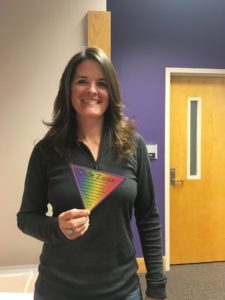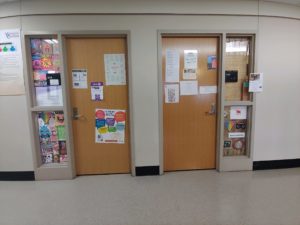
Ronda Wright, assistant director of intercultural affairs and one of the four Safe Zone coordinators. Photo by Bonnie MacAlister.
Story was co-written by Bonnie MacAlister.
The Dogwood room was brimming with voices from those participating in stage 2 of the Safe Zone Training. The topic of the activity was on coming out and different scenarios – a green star is when all is good, and you are accepted for who you are while a red star meant you ended up losing your friends, being disowned by your family, and having the world fall from under you. When I [Bonnie MacAlister] took this training several years ago, I got a red star and was not happy. For some in the LGBTQ+ community, that red star is their reality.
Western’s Safe Zone program, organized by the Department of Intercultural Affairs, offers faculty, staff, and students different strategies and communication techniques to help LGBTQ+ students. Participants will learn through select panels containing LGBTQ+ students and faculty what it means to be part of the LGBTQ+ community at Western. Different topics of discussion allow participants to engage in a way they couldn’t before with the community.
Hear what members of the LGBTQ+ on campus say about the program and how important it is for them.
“Mostly what I was looking for was more information specifically about terminology and language use, because our language is constantly changing, and I want to make sure the language I use is received appropriately. I don’t want to be offensive to a student,” Dr. Candy Noltensmeyer, an assistant professor in the Communication department, said. “I wanted to make sure I am setting a good standard to other students and faculty.”
Another professor teaching Communication, Dr. Scott Eldredge, took the training a few semesters back. His main purpose was to identify specific issues faced by the LGBTQ students and, with that, be able to demonstrate sensitivity to their needs.
“I wanted to be able to make it easy for them to find someone they could be comfortable with if and when they need that,” Eldredge said. “That’s the great thing about the training! It helps give you perspective on the needs of LGBTQ students. I don’t claim to have all the answers, but I do know that it is important to listen and truly try to imagine the world from the perspective of my students.”

Safe Zone signs on doors of the communication department at WCU. Photo by Kyrstin Roberts.
Professor and program director of the Master of Health Sciences, Dr. Brian Raming, who took the training, listed three main reasons why people to go through the training.
“First, I feel that awareness and experience is the key to breaking any prejudice or dispelling false stereotypes. Second, if this population feels that they do not have the resources, the support, and the appreciation for what they bring to this University, this state, this nation, or this life, then those who are a part of their community must change that feeling. [Finally] both sides of any negative perception of “the other” are responsible for the use of differences leading to segregation,” Raming said.
Assistant director of Intercultural Affairs and one of the Safe Zone coordinators, Ronda Wright, stresses the importance of the Safe Zone symbol in making people feel empowered and safe. She adds that one of the main missions of Safe Zone training is to provide reference material and resources about sexual orientation and gender identity and an educational resource and community while engaging in dialogue people may not be aware exist.
“This isn’t a certificate or master’s program. This is a brief summary in trying to start the conversation about inclusivity in community members and supportive environments. Each time it’s a different community having a conversation, so it’s great when other LGBTQ members come into this space and add to the discussion of their experience on campus and off as a member of the LGBTQ community,” Wright said.
According to the Safe Zone training website, the origin of Safe Zone is unknown. However, the idea and terminology have spread to non-profits, healthcare setting, and many other progressive organizations. The Safe Zone Project currently includes 25,000 educators in 100 different countries. WCU Safe Zone has been around for several years.
With Safe Zone having made its way to WCU, faculty and staff understand that it is more than just a sticker or symbol to stick to your door. It is a way to help improve lives and better understand diversity and the needs of the LBGTQ+ community on campus.


